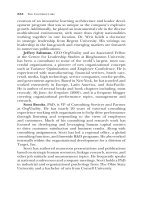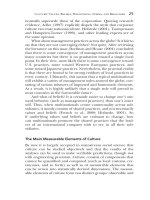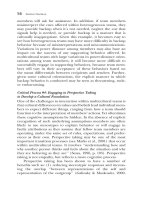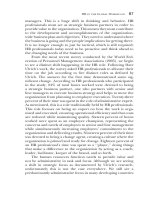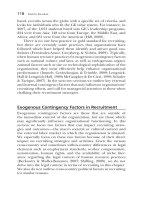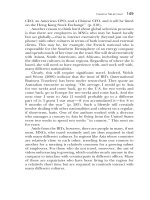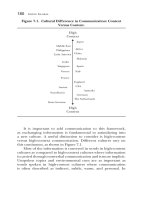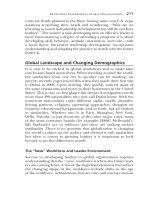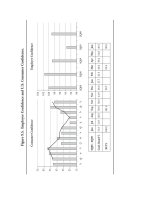Practical Applications and Recommendations for HR and OD Professionals in the Global Workplace_4 potx
Bạn đang xem bản rút gọn của tài liệu. Xem và tải ngay bản đầy đủ của tài liệu tại đây (486.22 KB, 31 trang )
56 Going Global
members will ask for assistance. In addition, if team members
misinterpret the cues offered within heterogeneous teams, they
may provide backup when it’s not needed, neglect the cue that
signals help is needed, or provide backup in a manner that is
culturally inappropriate. Given this example, it becomes easy to
see how heterogeneous teams may have more difficulty in backup
behavior because of misinterpretations and miscommunications.
Variations in power distance among members may also have an
impact on the success of any supporting behavior offered. In
multicultural teams with large variations in power-distance orien-
tations among team members, it will become more difficult to
successfully engage in supporting behaviors, because team mem-
bers will vary in their acceptance of these behaviors based on
the status differentials between recipients and senders. Further,
given some cultural orientations, the explicit manner in which
backup behavior is conducted may be seen as threatening, rude,
or embarrassing.
Critical Process #4: Engaging in Perspective Taking
to Develop a Cultural Foundation
One of the challenges to interaction within multicultural teams is
that cultural differences in values and beliefs lead individual mem-
bers to expect different things, ranging from how a team should
function to the interpretation of members’ actions. Yet oftentimes
these cognitive assumptions lie hidden. In the absence of explicit
recognition of such underlying assumptions members are often
likely to use stereotypes to explain behavior or will engage in
faulty attributions as they assume that fellow team members are
operating under the same set of rules, expectations, and prefer-
ences as their own. Perspective taking may be one of the most
important transition processes (see Marks et al., 2001) that occur
within multicultural teams. It involves ‘‘understanding how and
why another person thinks and feels about the situation and why
they are behaving as they are’’ (Sessa, 1996, p. 105). Perspective
taking is not empathy, but reflects a more cognitive process.
Perspective taking has been shown to have a number of
benefits such as: (1) reducing stereotypic responses and increas-
ing the overlap ‘‘between representations of the self and
representation of the outgroup’’ (Galinsky & Moskowitz, 2000,
Multicultural Teams: Critical Team Processes and Guidelines 57
p. 708), (2) encouraging social coordination and helping
behavior (Galinsky, Ku, & Wang, 2005), and (3) facilitating better
communication. Specifically, Sessa (1996) found that perspective
taking caused people to disclose more information and frame
their conversations in such a way that they were easily understood.
This, in turn, leads to overall greater success in multicultural
communications. In essence, perspective taking is a key aspect
of effective intercultural team interaction; it provides the founda-
tional knowledge pertaining to a recognition of the need to adapt
behavior in some manner and offers a mechanism through which
likely member actions can be projected in the future. However,
perspective taking is not a natural tendency. This is especially true
when it involves taking the perspective of members of another
culture. Though it has been argued that individuals who are high
in self-monitoring (Densten & Gray, 2003) are better at perspec-
tive taking than those who are low self-monitors, there may also be
interventions that can be designed and implemented to facilitate
this process (we will discuss this more later in the chapter).
Critical Process #5: Engaging in Negotiation to Find Common Ground
Negotiation is a process that is often ignored or minimized when
it comes to the delineation of important team processes. However,
within a multicultural setting negotiation becomes key to effective
interaction. Negotiation has been defined as ‘‘the ways in which
individuals manage their interdependence’’ (Walton & McKersie,
1965 as cited in Gelfand, Fulmer, & Severance, in press). In
addition, whereas negotiation may differ across cultures, Gelfand
et al. (in press) argue that there are several core characteristics that
should apply across cultures: there is a perception of conflicting
interests, communication is involved, a joint outcome exists, and
although there are mixed motives, compromise is possible.
Within multicultural teams negotiation is critical because
members often come to the team with disparate cognitive
structures that are based in their cultural orientations. These
knowledge structures, in turn, serve to affect the way each
individual member views the world, team interaction, and the
attributions that are made. Though there are situations in which
the knowledge structures are different but still compatible, it
is often the case that the differences are not initially compatible.
58 Going Global
It is the team leader’s job to facilitate a negotiated reality for
the team such that coordinated, adaptive action is enabled.
Researchers have argued that the emergence of a third culture
within multicultural teams is one of the mechanisms that
facilitates effective interaction (see Earley & Mosakowski, 2000).
However, negotiation is a complex process even when conducted
within a single culture; it becomes even more complex when
conducted within the context of a multicultural team. For
example, culture has been shown to affect the types of negotiation
strategies, the nature of the influence used in negotiation, as
well as the valued outcomes (Gelfand et al., 2002; Morris et al.,
2004; Gelfand & Brett, 2004). Although viewing negotiation
as the process by which differences in cultural values within a
single team are resolved is not the normal way this behavior is
examined in the literature, taking this approach within teams
is essential in order to achieve the common ground that allows
coordinated action. In engaging in this process Gelfand and
Dyer (2000) report that emotional appeals are thought to
be more impactful within collectivistic cultures, and rational
appeals more effective within individualistic cultures. Leaders
need to be cognizant of this difference when seeking to facilitate
a negotiated reality. For more detailed treatment of the role of
negotiation, the reader is referred to a recent review by Gelfand,
Fulmer, and Severance (in press).
Delineation of Emergent States
Although processes explain the manner in which interaction
occurs within multicultural teams, it is also essential to recognize
the effect that emergent states may have on multicultural teams.
Specifically, these cognitive and motivational states can arise as
the result of multicultural team interaction and, in turn, serve
as inputs to future interaction. As with the process variables,
there are many emergent states that have been identified within
the teams literature that may be argued to be important for the
successful interaction of multicultural teams, but due to space
constraints we limit our focus here to a few which we feel form
the foundation for success: psychological safety, shared mental
models, and transactive memory systems. See Figure 3.1 for a
visual representation.
Multicultural Teams: Critical Team Processes and Guidelines 59
Critical State #6: Creating a Sense of Psychological Safety
to Facilitate Interaction
Psychological safety has been defined as a shared belief regard-
ing the degree to which the team is perceived to be a safe
environment to engage in interpersonal risk taking (Edmond-
son, 1999). As such, psychological safety reflects a team climate
characterized by mutual respect and trust. Edmondson (2003)
found that psychological safety was important in culturally diverse
teams (such as medical teams) because it facilitated team inter-
action. For example, as the degree of psychological safety within
multicultural teams increases, members will be more willing to
take interpersonal risks, such as speaking up and offering con-
tributions during plan development or engaging in supporting
behaviors. One of the potential benefits of multicultural teams is
the diversity of vantage points that exist within these teams; psy-
chological safety helps the team to take advantage of this diversity
by promoting a climate in which members feel free to question
suggestions and decisions, in essence allowing members to play a
type of ‘‘devil’s advocate.’’ Furthermore, though cultures vary in
the degree to which they may engage in these actions, based on
power differentials and concerns about saving face, psychological
safety might play a role in mitigating some of these tendencies by
promoting a collective, holistic view of the team setting in which
out-groups are diminished.
Edmondson (2003) found that team leaders could promote
psychological safety within culturally diverse teams by engaging
in motivational, interpersonal activities and fostering a climate of
inclusion so that power differences were minimized and the input
of all members was recognized. As psychological safety reflects
a climate of trust and mutual respect, activities that promote
trust would be expected to facilitate a sense of safety. Within
multicultural teams, research has shown that not only does trust
have different relational bases, but also that cultures vary in
their motivational bases. Specifically, Yuki et al. (2005) found
that in more collectivist cultures (such as Japan) an important
basis on which team members based their decisions to trust each
other was the indirect interpersonal ties that existed between
them. Conversely, within more individualistic cultures (such as
the United States) decisions to trust were related to how well team
60 Going Global
members identified with each other, based on a shared category
of membership.
Critical State #7: Forming Compatible Cognitive Structures
to Aid Coordination
The possession of compatible knowledge structures have been
shown to facilitate performance and adaptation within teams
(Mathieu, Heffner, Goodwin, Salas, & Cannon-Bowers, 2000;
Entin & Serfaty, 1999). However, achieving these emergent states
is often very challenging within multicultural teams, because most
often members come to the team with very different knowledge
structures. These knowledge structures, as partially witnessed
through the metaphors used (see Gibson & Zellmer-Bruhn,
2002), guide member expectations, attributions, and interactions.
Shared mental models and transactive memory systems are two
categories of knowledge structures which, though difficult to
construct in multicultural teams, are essential for coordinated
action.
Both shared mental models and transactive memory are
aspects of shared understanding. Transactive memory system
(TMS) is defined as the collective knowledge within a group
that is coupled with the coordinated awareness of the knowl-
edge distribution among group members (Wegner, 1987). When
TMSs are effective, team members can easily assess who should
be responsible for which task based on a mutual understanding
of expertise, thereby reducing the cognitive load through more
efficient social information searches. Thus, using TMS within mul-
ticultural teams may affect communication patterns in that the
perceptions of where expertise lies within the team will differen-
tially guide interaction based on perceived expertise-based power
differences. In addition, when TMSs are accurate and knowledge
within them made explicit this may counter the tendency of indi-
viduals within multicultural teams to rely on false stereotypes and
inaccurate attributions.
TMS involves three primary components: specialization, or the
differentiation of information among team members; credibility,
or the beliefs of members regarding the accuracy and reliabil-
ity of others’ knowledge; and coordination, or the organized
knowledge processing of information (Akgun, Byrne, Keskin,
Multicultural Teams: Critical Team Processes and Guidelines 61
Lynn, & Imamgolu, 2005). Essentially, the root of this theory lies
upon distributed complementarity and compilational emergence,
where team members work as social information searchers to
determine who possesses which knowledge and expertise, and
then coordinate to ensure that the correct individuals are called
upon to utilize such knowledge.
Shared mental models (SMMs) are analogous to but unique
from TMS. Though SMMs are also a type of shared cognition
that works through distinct aspects of efficiency, there is not really
anything in the theory that mentionsspecialization of information.
This may be because SMMs were developed in teams, in which
a level of specialization is understood, as team members have an
inherent level of interdependency. Instead, SMM theory relies
more upon implicit coordination instead of social information
searchers (Edwards et al., 2006). SMMs are defined as organized
knowledge structures held in common among team members
in order to allow them to act in coordinated ways (Mathieu,
et al., 2000).
SMMs are characterized by four main types of models:
technology/equipment, which hold information such as equipment
functioning, operating procedures, and system limitations;
job/task, which hold information such as task procedures, likely
scenarios, and task strategies; team interaction, which hold infor-
mation such as roles, responsibilities, and information sharing;
and team, which hold information such as teammates’ knowledge,
skills, and attitudes (Cannon-Bowers, Salas, & Converse, 1993). In
order to be successful, it is expected that team members need to
not only possess accurate and similar information regarding tasks,
butalsomustbeabletoworktogetherwellasateam(Edwards,
Day, Arthur, & Bell, 2006). Whereas compatible task-related
mental models may be fairly straightforward within multicultural
teams, it is the knowledge structures governing team interaction
that are typically more divergent. It is these more complex knowl-
edge structures which need to be negotiated, or at a minimum
made salient, so team members are cognizant of member pref-
erences and can predict and adapt to member action as needed.
In all, compatible knowledge structures are especially critical
to develop because of the inherent diversity of cognition within
multicultural teams and the misattributions these can cause.
62 Going Global
Guidelines for Improving Multicultural Teamwork
Certainly, the aforementioned processes, states, and associated
challenges of multicultural teamwork can be difficult to over-
come. Indeed, developing methods for reducing problems and
maximizing the benefits of multicultural collaboration has been
a struggle for researchers (van Knippenberg & Schippers, 2007).
However, drawing from what is currently known regarding how to
prepare diverse teams to work together, and about general team
training principles, it is possible to provide guidelines that can
aid practitioners in reducing some of the challenges to success-
ful performance in such collaborations. These guidelines can be
divided according to the temporal frame in which their imple-
mentation is most effective: pre-interaction, during interaction,
and post-interaction.
Guidelines targeted at the pre-interaction phase on setting a
common ground for members of multicultural teams before team
processes are initiated. This will facilitate shared cognition and
skill-based processes that will encourage team members to utilize
a sense of cultural awareness in their multicultural environment,
while also reducing the negative impact of ethnocentric tenden-
cies. Guidelines that can be implemented during interaction are
primarily targeted at enhancing coordination across team mem-
bers, as this is a particularly challenging issue for multicultural
teams. Finally, guidelines can also facilitate post-interaction as a
means to improve future multicultural team interactions, either
within the same team or as team members move on to new teams.
These guidelines are centered on facilitating feedback to team
members regarding what went well during interaction, what could
be improved, and how to approach future interactions success-
fully. The next section provides a more in-depth look at the
processes occurring within each phase and corresponding guide-
lines to enhance multicultural teamwork that can be implemented
to enhance multicultural teamwork. The following list provides a
summary of guidelines.
Guidelines for Improving Multicultural Teams
1. Utilize training that incorporates cultural self-awareness as well
as mitigation of ethnocentric tendencies.
Multicultural Teams: Critical Team Processes and Guidelines 63
2. Implement training that emphasizes perspective taking.
3. Incorporate advanced organizers into training.
4. Utilize textual & video vignette-based situational judgment tests
to promote cross-cultural skill development.
5. Establish a set of team norms, behaviors, and beliefs to create a
hybrid culture that emphasizes a combination of team member
cultural characteristics.
6. Encourage teammembersto discusstheir similarities,especially
at the socio-contextual level.
7. Enhance coordination through the use of regulatory commu-
nication and realignment.
8. Facilitate cognitive emergent states and behavioral-based
processes through the execution of AARs following team
interaction.
Pre-Interaction Phase
Before members of multicultural teams even begin to interact,
there are several phases that can be leveraged to ensure that effec-
tive team processes occur. First, a primary issue in multicultural
teams is the proclivity for a lower degree of shared understanding
among team members due to cultural differences (Cramton &
Hinds, 2005). Shared understanding among team members can
be captured through shared mental models; the shared mental
representations held by team members; the team’s transactive
memory system; or the collective knowledge within the group
(Wegner, 1987). Therefore, addressing this prior to team perfor-
mance can aid in reducing some of the misunderstandings and
communication failures that arise from differences in logic and
information storage (Kayworth & Leidner, 2002; Baba, Gluesing,
Ratner, & Wagner, 2004).
In addition to forming accurate shared understanding among
team members, a strong foundational set of skills that are neces-
sary to interact in multicultural environments can be cultivated
prior to multicultural interaction. Doing so will enhance cultural
awareness and ensure that team members have the appropriate
skills in their repertoire when faced with new or challenging
cultural situations (Salas, Wilson, & Lyons, 2009). Encouraging
team members to practice their skills in a safe environment,
64 Going Global
such as through the use of situational judgment tests, should
aid in facilitating the transfer of these skills during real inter-
actions (Bhawuk & Brislin, 2000). The following discussion pro-
vides a more detailed explanation regarding how both shared
knowledge and skill-based processes can be developed during
pre-interaction.
Facilitating Shared Mental Models & TMS
Developing at least some degree of a shared understanding among
multicultural team members is a critical pre-interaction step.
As previously discussed, shared mental models and transactive
memory systems can enable team performance by reducing con-
fusion regarding who can provide a particular expertise. Shared
understanding will also streamline communication, coordina-
tion, and comprehension of new knowledge (Cramton, 2001).
However, it is often the case in multicultural environments
that the development of shared mental models and transac-
tive memory is much more complicated than in homogenous
environments. Individuals in homogeneous teams tend to report
stronger feelings of affinity and ease of interaction than those
in multicultural environments (Ibarra, 1992). Individuals from
different cultures bring their own methods for storing, retriev-
ing, and exchanging information, which while at times can
be advantageous (for example, in preventing groupthink and
promoting creativity), can also be detrimental to the forma-
tion of a shared knowledge system (Adler, 1991; Williams &
O’Reilly, 1998).
However, this does not mean that developing a shared
understanding among multicultural team members is impossible.
Indeed, multicultural teams should strive to develop a shared
meaning system in order to overcome the negative impacts of
cultural diversity and promote effective interactions (Gibson &
Earley, 2002). Furthermore, establishing shared mental models
and a transactive memory system early on in multicultural team
development can aid in reducing or preventing later conflicts
and setting the tone for information sharing within the team. To
accomplish this, several strategies can be enacted during the early
stages of team development in order to promote a lasting and
beneficial shared knowledge system.
Multicultural Teams: Critical Team Processes and Guidelines 65
Guideline #1: Utilize Training That Incorporates Cultural
Self-Awareness as Well as Mitigation of Ethnocentric Tendencies
The first strategy that can help establish a shared understand-
ing in multicultural teams is the use of cultural self-awareness
training to mitigate ethnocentric tendencies. Cultural awareness
training is based upon the idea that individuals who have a better
understanding of their own culture will be more effective and
aware of the cultural norms, beliefs, and behaviors of other cul-
tures (Bennett, 1986). Therefore, this type of training is designed
to first educate an individual about his or her own culture so
that when interacting with individuals from different cultures
the trainee will appreciate differences instead of ignoring them
or reacting negatively (Littrell & Salas, 2005). Furthermore, as
individuals are driven by their cultural beliefs and norms, it is
often the case that a tendency to view one’s own culture as supe-
rior will cloud interactions with others from different cultures
(Bussema & Nemec, 2006; Salas et al., 2009). Therefore, before
cultural interactions begin, bringing team members ‘‘back to the
basics’’ by encouraging an awareness of their own cultural beliefs,
biases, feelings, and responses to culture can aid team members
in developing a common understanding of cultural similarities,
differences, and biases. This can in turn reduce ethnocentric
behaviors and lead to greater tolerance and flexibility in cul-
tural perspectives, leading team members to be more effective in
creating shared knowledge structures as they begin to perceive
commonalities and acknowledge beneficial differences with their
team members.
Guideline #2: Implement Training That Emphasizes
Perspective Taking
In relation to enhancing team member cultural self-awareness
as a means of improving the development of shared knowledge,
multicultural teams can also benefit from training in perspective
taking, which is a social cognitive process of perceiving something
from the viewpoint of another person (Fiske & Taylor, 1984).
Perspective taking is particularly beneficial in cross-cultural envi-
ronments, as it allows an individual to assume the perspective of
another person during interactions, therefore enhancing under-
standing and the likely success of the interaction. Perspective
66 Going Global
taking has been found to be a valuable skill in cross-cultural
interactions, as Imai and Gelfand (under review) noted in their
study of cross-cultural negotiations. Their study demonstrated
that individuals adept at perspective taking were more effective in
maintaining cooperative sequences of behavior and ultimately
achieving higher outcomes with individuals from a different
culture.
For the development of a shared knowledge system in mul-
ticultural teams, perspective taking is pivotal. Being able to take
another’s perspective can facilitate a better understanding as to
why one team member may view a construct differently from
another, and can aid in reaching a consensus regarding that con-
struct (or agreeing to disagree in the case of equally viable quality
mental models). Furthermore, perspective taking can aid team
members in being able to better predict each other’s actions,
regardless of their cultural origins.
In order to train perspective taking, providing safe opportu-
nities to practice may be most beneficial. Practice-based training
methods offer a mode of active learning that is necessary for team
members to more completely develop their repertoire of skills; this
is particularly beneficial for a more complex skill such as perspec-
tive taking (Salas & Cannon-Bowers, 2000). There are a number
of practice strategies that can be utilized, ranging from low-
fidelity role playing with actors or team members to high-fidelity
computer-based simulations of a real person (Fowler, 1994). No
matter which type of practice is selected, it is necessary to ensure
that these practices occur in a ‘‘safe’’ environment in which team
members can make errors without the same consequences that
they would experience in the real world. Scenario-based training
may also be useful for perspective taking, as it provides team
members with examples of critical incidents, leading to both
positive and negative outcomes, to which they can apply their
knowledge of perspective taking and reflect upon how they would
have responded in the given situation (Bhawuk & Brislin, 2000).
Regardless of the approach utilized, ensuring that team mem-
bers have the opportunity to practice taking perspectives prior to
their interactions as a team can enable more open and effective
communication that will lead to better shared knowledge systems.
Multicultural Teams: Critical Team Processes and Guidelines 67
Guideline #3: Incorporate Advanced Organizers into Training
A final way to enhance a shared understanding across members of
a multicultural team during training is to provide team members
with advanced organizers, which are commonly utilized in the
beginning of a training program to provide a guiding theoretical
framework to trainees (Kraiger, Salas, & Cannon-Bowers, 1995).
As novel content is more likely to be understood and recalled when
linked to existing knowledge, providing an advanced organizer
as a conceptual framework aids in the facilitation of training
organization and retention of the new information gained (Mayer
1979; 1989). Advanced organizers may be as simple as a brief
outline of the training modules and objectives or as complex as a
complete reference guide that can be consulted throughout the
training program.
Advanced organizers have been found to enhance training
effectiveness, particularly for programs such as cultural training
where content is complex. Bhawuk (1998; 2001) proposed that
cultural assimilators are more successful when linked to a cul-
tural theory that gives trainees a means by which to make sense of
cultural differences. Furthermore, by providing the entire team
with an advanced organizer, a shared understanding can be facil-
itated through a common understanding of the training and its
goals, thus enhancing not only the training itself, but also serving
as an initial foundation upon which team members can begin to
develop a shared knowledge system.
Facilitating Skill-Based Processes
An effective shared knowledge system is not the only area in which
to target multicultural team enhancement prior to actual team
process and performance. Team members can also work to refine
their cross-cultural skills before performing as a team, in order
to ensure that they will be able to operate effectively in a mul-
ticultural environment. As many different types of cross-cultural
skills, including flexibility, social intelligence, and adaptability,
have been recognized as being important for success in multicul-
tural teams; instead of focusing on particular skills, we will address
the training techniques that can best foster development of these
68 Going Global
skills in a pre-interaction environment—namely, through the use
of situational judgment tests (SJTs).
Guideline #4: Utilize Written and Video Vignette–Based Situational
Judgment Tests to Promote Cross-Cultural Skill Development
SJTs are a form of practice that can be implemented quickly
and easily, either through the use of written tests or through
video vignettes, in order to ensure that team members possess
necessary cross-cultural abilities prior to interacting (Fritzsche,
Stagl, Salas, & Burke, 2006). This ease of implementation provides
a fast way to provide feedback to team members and address
any major gaps in skills prior to actual interaction, potentially
preventing conflicts and misunderstandings. Furthermore, the
ability to incorporate both written and visual information into
SJTs by using different media can provide a richer and more
interactive learning environment that enables active learning and
promotes better skill development.
Situational judgment tests typically consist of a set of inci-
dents and the alternative actions that could be taken to deal
with each incident (Chan & Schmitt, 1997). SJTs have most
commonly been used as a selection tool or a method to assess per-
formance (Motowidlo, Hason, & Crafts, 1997). However, for the
purpose of preparing team members to interact in multicultural
environments, they can be used to create an immediately active
experience on the part of learners and provide useful informa-
tion about their present understanding of and attitudes toward
the importance of cross-cultural skills. The ease with which these
SJTs can be adapted to a team situation is also beneficial, as crit-
ical incidents can be designed for a range of cross-cultural skills
and implemented as needed by multicultural teams. This allows
a team to receive feedback on the skills most pertinent to its
given situation and context, as opposed to a mix of relevant and
irrelevant skills.
Although SJTs typically are conducted using text-based critical
incidents, video SJTs are increasing in popularity, particularly as
a training tool (Fritzsche et al., 2006). Video SJTs show trainees a
sketch or situation that they are then asked to respond to, just as
in a paper-based SJT. In learning environments, video vignettes
are used to demonstrate or allow individuals to practice a single
Multicultural Teams: Critical Team Processes and Guidelines 69
skill or set of skills. Because they can lend context and richness to
a learning environment, video vignettes have been proven useful
in numerous domains. For example, there are results suggesting
improvements in the reflective thinking of teachers (Calandra,
Gurvitch, & Lund, 2008) as well as potential for teaching busi-
ness ethics (Meisel & Fearon, 2006). Developing cultural skills
appears to be a prime use for video-based SJTs, as they can
highlight slight cultural nuances, such as nonverbal cues or cul-
tural artifacts, which a paper-based SJT cannot communicate as
richly. In culturally sensitive situations video vignettes have been
used to evaluate inappropriate behaviors and promote the use of
culturally appropriate behaviors (Molinksy & Perunovic, 2008).
Exposing multicultural teams to such safe practice environments
in which they can further develop their skills prior to real interac-
tion is therefore a critical advantage to the use of both text- and
video-based SJTs.
During Interaction Phase
As discussed, there are many critical components to consider when
interacting in multicultural teams. Though multiple processes
occur during the interaction phase of multicultural collaborations,
for the purposes of identifying guidelines, the majority can be
grouped into one of the following categories: communication,
coordination, and cooperation. As noted, team communication
involves the management of information flow, development of
plans and strategy, and the solicitation of feedback (Sims & Salas,
2007). Team cooperation involves the desire of team members to
work together and perform as a team. Team coordination is vital
to team performance, as it is a composition of the behavioral and
cognitive mechanisms required for task performance (Marks et al.,
2001). Combined, these three larger facets represent the factors
that comprise, contribute to, facilitate, and detract from effective
team performance during the interaction phase. Breakdowns in
any of these processes can lead to lasting damages to multicultural
team performance.
Unfortunately, as multicultural teams begin to interact
through these three processes, it is very possible that despite
the best efforts prior to interaction, negative effects of multi-
culturalism will reemerge to some degree. These effects can
70 Going Global
include the highlighting of differences, the development of fault
lines, and the emergence of conflict (Jarvenpaa & Leidner,
1999; Lau & Murningham, 1998). Therefore, it is important to
recognize what strategies can be utilized during interaction
to maximize performance during this action phase and minimize
any negative effects of multiculturalism. The following discussion
provides three suggested guidelines that can be utilized to
facilitate coordination, cooperation, and communication during
interactions, namely through the development of a hybrid
culture, emphasizing similarities among team members, and
establishing a systematic means for coordination.
Guideline #5: Establish a Set of Team Norms, Behaviors, and Beliefs
to Create a Hybrid Culture That Emphasizes a Combination
of Team Member Cultural Characteristics
It is undeniable that multicultural team members bring their own
cultural influences, norms, and beliefs into their team interaction.
However, this does not have to be a detriment to team perfor-
mance if members are able to meld their cultural values into a new,
hybrid team culture (Earley & Mosakowski, 2000). A hybrid team
culture is a new set of norms, rules, expectations, and behaviors
that individuals within a team create themselves after some period
of interaction. The degree to which these values are shared deter-
mines the strength of the culture, but the establishment of any
degree of team culture that can unify members would be a benefit
during team interaction. Indeed, Earley and Mosakowski (2000)
found in their qualitative field study of transnational teams that
highly heterogeneous teams who created their own team identity
were more successful than moderately heterogeneous groups lack-
ing a team identity. Recognizing that they had a high degree of
diversity and differences among their team members, the highly
heterogeneous groups decided to minimize the negative impacts
of these effects by creating of a team culture that could bridge
their cultural differences. The moderately heterogeneous teams
who did not recognize the benefit of such a shared identity were
less successful. Therefore, multicultural teams, regardless of how
diverse they are, may benefit from the development of a team
hybrid culture.
Multicultural Teams: Critical Team Processes and Guidelines 71
Guideline #6: Emphasize Similarities Among Team Members
Even if cross-cultural skills are fine-tuned and shared knowledge
systems are established before interaction, it is still likely that as
team members begin to work with one another their cultural
differences may impede on successful performance. Therefore,
a continued emphasis on similarities and a ‘‘superordinate team
identity’’ among team members can further aid in the mainte-
nance of a healthy team environment. Individuals tend to have
a preference for working with others similar to themselves and
often findthis type ofinteraction mucheasier than interacting with
those who are perceived as different (Williams & O’Reilly, 1998).
Furthermore, team member similarity is positively associated with
team effectiveness (Tsui, Egan, & O’Reilly, 1992).
Although it may be difficult for team members in very het-
erogeneous teams to find similarities, it is important that teams
move beyond surface-level similarities. Similarities do not need to
be merely obvious, such as gender, race, or age, to be effective at
drawing team members together. In fact, in terms of establishing
long-term ties, homophily based on such surface-level factors is
less important than homophily stemming from deeper sociocon-
textual characteristics (Yuan & Gay, 2006). Therefore, it may be
beneficial to provide opportunities for team members to recog-
nize their similarities. This could be achieved through a simple
question-and-answer session with team members or through peri-
odic reminders of similarities from the team leader. Regardless
of the strategy, encouraging team members to find similarities
among themselves should aid in enhancing team interaction.
Guideline #7: Enhance Coordination Through the Use of Regulatory
Communication and Realignment
A final means by which to successfully maintain multicultural team
processes of coordination, communication, and cooperation dur-
ing the interaction phase is to introduce a systematic means of
coordinating and communicating. This may tie in with the devel-
opment of a hybrid culture, as it involves creating a systematic
method by which team members can expect regular commu-
nications regarding their performance, and a way for teams to
determine if they need to realign their efforts based on their
current performance status. Essentially, this idea builds upon the
72 Going Global
premise of team self-correction, in that team members develop
an approach for communication and coordination that enables
them to work together in order to identify breakdowns as early
as possible and to provide a systematic means by which to cor-
rect these breakdowns (Sims, Salas, & Burke, 2005). Self-guided
correction in teams is a successful strategy for enhancing team
performance, as has been found in both laboratory and field
settings (Smith-Jentsch, Zeisig, Acton, & McPherson, 1998).
Though beneficial for homogenous teams, for multicultural
teams this strategy can be particularly invaluable, as it sets up
formal procedures—based on or as a part of the team’s own hybrid
culture—that regulate how communication should be conducted
and how members can address problems or malfunctions in team
performance. As cultural differences can often restrict individuals’
comfort level about reporting errors, this provides a structured,
acceptable method by which such feedback can be provided,
maintaining a balance between individual cultural needs and the
needs of the team as a performing entity.
Post-Interaction Phase
The completion of interaction in a multicultural collaboration is
not simply the end of performance; instead, lessons learned from
the interaction itself can provide a rich basis for success in future
multicultural collaborations. These lessons are best facilitated
through the use of an after-action review (AAR).
Guideline #8: Facilitate Cognitive Emergent States and Behavioral
Based Processes through the Execution of AARs Following
Team Interaction
AARs are guided debriefings which usually occur after a period
of performance and are designed to review behavior in order to
determine whatwent well,what could be improved, andhow future
scenarios will be approached. These guided debriefings provide
team members with a means by which to ‘‘discern the rules of
behavior which transcend thespecifics of a given scenario’’ (Smith-
Jentsch, Cannon-Bowers, Tannenbaum, & Salas, 2008, pg. 311),
thus enhancing adaptive transfer to novel situations. AARs have
been heavily leveraged as a training mechanism within military
Multicultural Teams: Critical Team Processes and Guidelines 73
settings (such as team dimensional training or guided team self-
correction) and have demonstrated significant, positive impact on
shared mental models, team processes, and both individual and
team performance (see Ellis & Davidi, 2005; Smith-Jentsch et al.,
2008; Smith-Jentsch et al., 1998). For example, Ellis and Davidi
(2005) compared the impact of traditional failure-focused AARs
(FAAR) to the impact of AARs which focused on both failures
and successes (FSAAR) during hands-on navigation training in a
sample of elite military defense forces. Results demonstrated that
both groups significantly increased performance over the course
of three hands-on navigation training exercises, however, indi-
viduals who partook in the FSAARs demonstrated significantly
greater performance gains. Additionally, trainees who partici-
pated in FSAARs demonstrated richer mental models of their
performance, suggesting more systematic, critical thinking.
These types of AARs can be very beneficial for multicultural
teams, as they provide a means by which team members can
analyze both their cultural skill and their performance as a team.
Providing multicultural teams with both performance and process
feedback is critical, as these teams should be aware not only of
their capabilities to work with others from different cultures, but
also of how they worked as members of a team. If team members
are only provided with overall team results and no feedback
regarding the specific processes that led to their success or failure,
performance may be falsely attributed to cultural differences or
similarities, or to team abilities. Therefore, developing a formal
feedback process such as an AAR by which team members can
analyze their performance and gain insight will only enable them
to perform more effectively in future multicultural teams.
Concluding Comments
Multicultural teams are by no means a new phenomena, for global
organizations have been in existence for decades. However, most
of the work that has been conducted on cultural differences
within teams has taken an intracultural perspective. Recently,
there has been an emerging shift within this literature to also
examine intercultural differences. It is only through this focus
that researchers and practitioners can better understand the
74 Going Global
challenges and guidelines for teams in which members have
disparate cultural orientations.
Much of what is currently known about multicultural inter-
action is leveraged from our knowledge of teams, diversity, and
culture—but few efforts have focused on the actual intercul-
tural differences. Within this chapter we have highlighted a few
of the processes and emergent states which, based on the sci-
entific literature, may be argued to be critical for the effective
functioning of multicultural teams. Specifically, negotiation, com-
munication, and supporting behavior provide the foundation and
the processes of perspective taking and leadership can facilitate
the mitigation of faultlines and process decrements which often
exist early in the team’s lifespan. These processes will, in turn,
have an impact on the resulting cognitive structures (such as
shared mental models, transactive memory systems) and attitudes
(such as psychological safety). Although these processes and states
are important to multicultural team effectiveness, there are many
challenges in implementing them; therefore, we have begun to
identify an initial set of guidelines that can be targeted along
a continuum of pre-action intervention, real-time intervention,
and post-action intervention. It is our hope that this will serve to
stimulate further research and discussion.
Acknowledgment
This work was partially supported by funding from the Army
Research Laboratory’s Advanced Decision Architecture Collab-
orative Technology Alliance Cooperative Agreement (AAD19-
01-2-0009) and the Office of Naval Research MURI Grant to
Dr. Michele Gelfand, Principal Investigator, UMD (W911NF-08-1-
014), subcontract to UCF (Z885903). The views expressed in this
work are those of the authors and do not necessarily reflect the
organizations with which they are affiliated or their sponsoring
institutions or agencies.
References
Adler, N. J. (1991). International dimensions of organizational behavior.
Belmont, CA: Wadsworth.
Akgun, A. E., Byrne, J., Keskin, H., Lynn, G. S., & Imamgolu, S. Z.
(2005). Knowledge networks in new product development projects:
Multicultural Teams: Critical Team Processes and Guidelines 75
A transactive memory perspective. Information & Management,
42(8), 1105–1120.
Argote, L. & McGrath, J. D. (1993). Group processes in organisations:
Continuity and change. In C. L. Cooper & I. T. Robertson (Eds.),
International review of industrial and organisational psychology,Vol.8.
New York: Wiley.
Ayoko, O. B., Hartel, C. E. J., & Callan, V. J. (2002). Resolving the
puzzle of productivity and destructive conflict in culturally hetero-
geneous workgroups: A communication accommodation theory
approach. The International Journal of Conflict Management, 13(2),
165–195.
Baba, M. L., Gluesing, J., Ratner, H., & Wagner, K. H. (2004). The
contexts of knowing: Natural history of a globally distributed team.
Journal of Organizational Behavior, 25, 547–587.
Bantz, C. R. (1993). Cultural diversity and group cross-culture team
research. Journal of Applied Communication, 21(1), 1–20.
Bennett, M. (1986). Towards ethnorelativism: A developmental model
of intercultural sensitivity. In R. M. Paige (Ed.), Education for the
intercultural experience (pp. 21–71). Yarmouth, ME: Intercultural
Press.
Bhawuk, D. P. S., & Brislin, R. W. (2000). Cross-cultural training: A review.
Applied Psychology: An International Review, 49(1), 162–91.
Bhawuk, D. P. S. (1998). The role of culture theory in cross-cultural train-
ing: A multimethod study of culture-specific, culture-general, and
culture theory-based assimilators. Journal of Cross-Cultural Psychology,
29(5), 630.
Bhawuk, D. P. S. (2001). Evolution of culture assimilators: Toward theory-
based assimilators. International Journal of Intercultural Relations,
25(2), 141–163.
Burke,C.S.,Stagl,K.C.,Klein,C.,Goodwin,G.,Salas,E.,&Halpin,
S. M. (2006). What types of leadership behaviors are functional in
teams? A meta-analysis. Leadership Quarterly, 17, 288–307.
Bussema, E., & Nemec, P. (2006). Training to increase cultural compe-
tence. Psychiatric Rehabilitation Journal, 30(1), 71–73.
Calandra, B., Gurvitch, R., & Lund, J. (2008). An exploratory study of
digital video editing as a tool for teacher preparation. Journal of
Technology & Teacher Education, 16(2), 137–153.
Cannon-Bowers, J. A., Salas, E., & Converse, S. A. (1993). Shared mental
models in expert team decision making. In N. J. Castellan, Jr. (Ed.),
Individual and group decision making: Current issues (pp. 221–246).
Hillsdale, NJ: LEA.
Chan, D., & Schmitt, N. (1997). Video-based versus paper-and-pencil
method of assessment in Situational Judgment Tests: Subgroup
76 Going Global
differences in test performance and face validity perceptions. Jour-
nal of Applied Psychology, 82, 143–159.
Chen, G., Tjosvold, D., & Liu, C. (2006). Cooperative goals, leader
people and productivity values: Their contribution to top man-
agement teams in China. Journal of Management Studies, 43(5),
1177–1200.
Conyne, R., Wilson, F., Tang, M., & Shi, K. (1999). Cultural similarities
and differences in group work: Pilot study of a U.S Chinese group
comparison. Group Dynamics: Theory, Research, and Practice, 3(1),
40–50.
Cox, T. H., Lobel, S. A., & McLeod, P. L. (1991). Effects of ethnic group
cultural differences on cooperative and competitive behavior on a
group task. Academy of Management Journal, 34(4), 827–847.
Cramton, C. D., & Hinds, P. J. (2005). Subgroup dynamics in internation-
ally distributed teams: Ethnocentrism or cross-national learning?
Organizational Behavior, 26, 231–263.
Cramton, C. D. (2001). The mutual knowledge problem and its con-
sequences for dispersed collaboration. Organization Science, 12,
346–371.
Den Hartog, D. N., & Verburg, R. M. (1997). Charisma and rhetoric:
Communicative techniques of international business leaders. Lead-
ership Quarterly, 8(4), 355–391.
Densten, I. L., & Gray, J. H. (2003). Leadership applications: Organi-
zational effectiveness. (CFLI Contract Research Report #CR02–
0620). Kingston, ON: Canadian Forces Leadership Institute
Dinwoodie, D. L. (2005). Solving the dilemma: A leader’s guide to
managing diversity. Leadership in Action, 25(2): 3–6.
Earley, P. C., Gibson, C. B., & Chen, C. C. (1999). How did I do? Versus
how do we do? Cultural contrasts of performance feedback use and
self-efficacy. Journal of Cross-Cultural Psychology, 30(5) 594–619.
Earley, P. C., & Mosakowski, E. (2000). Creating hybrid team cultures:
An empirical test of transnational team functioning. Academy of
Management Journal, 43, 26–49.
Edmondson. A. (2003). Speaking up in the operating room: How team
leaders can promote learning in interdisciplinary action teams.
Journal of Management Studies, 40(6), 1419–1452.
Edmondson, A. (1999). Psychological safety and learning behavior in
work teams. Administrative Science Quarterly, 44, 350–383.
Edwards, B. D., Day, E. A., Arthur, W., & Bell, S. T. (2006). Rela-
tionships among team ability composition, team mental models,
and team performance. Journal of Applied Psychology, Vol. 91(3),
727–736.
Multicultural Teams: Critical Team Processes and Guidelines 77
Ellis, S., & Davidi, I. (2005). After-event reviews: drawing lessons from
successful and failed experience. Journal of Applied Psychology, 90(5),
857–871.
Elron, E. (1997). Top management teams within multinational corpo-
rations: Effects of cultural heterogeneity. Leadership Quarterly, 8,
393–412.
Entin, E. E., & Serfaty, D. (1999). Adaptive team coordination. Human
Factors, 41, 312–325.
Fiske, S. T., & Taylor, S. E. (1984). Social cognition.NewYork:Random
House.
Fowler, S. M. (1994). Two decades of using simulation games for cross-
cultural training. Simulation & Gaming, 25, 464–476.
Fritzsche, B. A., Stagl, K. C., Salas, E., & Burke, C. S. (2006) Enhancing
the design, delivery and evaluation of scenario-based training: Can
situational judgment tests contribute? In J. A. Weekley, and R. E.
Ployhart, (Eds.), Situational judgment tests: Theory, measurement and
application (pp. 301–318). Mahwah, NJ: Erlbaum.
Galinsky, A. D., Ku, G., & Wang, C. S. (2005). Perspective-taking and
self-other overlap: Fostering social bonds and facilitating social
coordination. Group Processes & Intergroup Relations, 8(2), 109–124.
Galinsky, A. D., & Moskowitz, G. B. (2000). Perspective-taking:
Decreasing stereotype expression, stereotype accessibility, and
in-group favoritism. Journal of Personality and Social Psychology, 78(4),
708–724.
Gelfand, M. J., & Brett, J. M. (Eds.) (2004). The handbook of negotiation
and culture. Stanford, CA: Stanford University Press.
Gelfand, M. J., & Dyer, N. (2000). A cultural perspective on negotiation:
Process, pitfalls, and prospects. Applied Psychology, 49, 62–99.
Gelfand, M. J., Erez, M., Aycan, Z. (2007). Cross-cultural organizational
behavior. Annual Review of Psychology, 58, 479–514.
Gelfand, M. J., Fulmer, C. A., & Severance, L. (in press). The psychology
of negotiation and mediation. In S. Zedeck (Ed.), Handbook of
industrial and organizational psychology.
Gelfand, M. J., Higgins, M. Nishii, L. H., Raver, J. L., & Dominguez A.,
et al. (2002). Culture and ego-centric biases of fairness in conflict
and negotiation. Journal of Applied Psychology, 87, 833–845.
Gelfand, M. J., Nishii, L., & Raver, J. (2006). On the nature and impor-
tance of cultural tightness-looseness. Journal of Applied Psychology,
91, 1225–1244.
Gersick, C. J. G., & Hackman, J. R. (1990). Habitual routines in task
performing groups. Organizational Behavior and Human Decision
Processes, 47, 65–97.
78 Going Global
Gibson, C. B. (1999). Do they do what they believe they can? Group
efficacy beliefs and group performance across tasks and cultures.
Academy of Management Journal, 42, 138–152.
Gibson, C. B., & Earley, P. C. (2002). Multinational teams: A new perspective.
Mahwah, NJ: Erlbaum.
Gibson, C. B., & Zellmer-Bruhn, M. E. (2001). Metaphors and meaning:
An intercultural analysis of the concept of teamwork. Administrative
Science Quarterly, 46, 274–303.
Gibson, C. B., & Zellmer-Bruhn, M. E. (2002). Minding your metaphors:
Applying the concept of teamwork metaphors to the management
of teams in multicultural contexts. Organizational Dynamics, 31(2),
101–116.
Golden, T. D., & Veiga, J. F. (2005). Spanning boundaries and borders:
Toward understanding the cultural dimensions of team boundary
spanning. Journal of Managerial Issues, 17(2), 178–197.
Hackman, J. R. (2002). Leading teams: Setting the stage for great performances.
Boston: HBS Press.
Hackman, J. R., & Wageman R. (2005). A theory of team coaching. The
Academy of Management Review, 30(2), 269–287.
Hall, E. T., & Hall, M. R. (1990). Understanding cultural differences: Germans,
French, and Americans. Boston: Intercultural Press.
Harrison, G. L., McKinnon, J. L., Wu, A., & Chow, C. W. (2000). Cultural
influences on adaptation to fluid workgroups and teams. Journal of
International Business Studies, 31, 489–505.
House, R. J., Hanges, P. W., Javidan, M., Dorfman, P., & Gupta, V. (2004)
(Eds.). Culture, leadership, and organizations: The GLOBE study of 62
societies. Thousand Oaks, CA: Sage.
House, R. J., & Javidan, M. (2004). Overview of GLOBE. In R. J. House,
P.J.Hanges,M.Javidan,P.W.Dorfman,&V.Gupta(Eds.),
Culture, leadership, and organizations: The GLOBE study of 62 societies
(pp. 9–28). Thousand Oaks, CA: Sage.
Ibarra, H. (1992). Homophily and differential returns: Sex differences in
network structure and access in and advertising firm. Administrative
Science Quarterly, 37, 422–477.
Ilgen, D. R., LePine, J. A., & Hollenbeck, J. R. (1997). Effective decision
making in multinational teams. In P. C. Earley & M. Erez (Eds.),
New perspectives on international industrial/ organizational psychology.
San Francisco: Pfeiffer.
Imai, L., & Gelfand, M. J. (under review). The culturally intelligent
negotiator: The impact of cultural intelligence (CQ) on negotiation
sequences and outcomes.
Multicultural Teams: Critical Team Processes and Guidelines 79
Jarvenpaa, S. L., & Leidner, D. E. (1999). Communication and trust in
global virtual teams. Organization Science, 10, 791–815.
Kayworth, T. R., & Leidner, D. E. (2001–2002). Leadership effectiveness
in global virtual teams. Journal of Management Information Systems,
18, 7–40.
Kirchmeyer, C., & Cohen, A. (1992). Multicultural groups: Their perfor-
mance and reactions with constructive conflict. Groups & Organiza-
tion Studies, 17(2), 153–170.
Kirkman, B. L., & Shapiro, D. L. (2001). The impact of cultural values on
job satisfaction and organizational commitment in self-managing
work teams: The mediating role of employee resistance. Academy of
Management Journal, 44, 557–569.
Kraiger, K., Salas, E., & Cannon-Bowers J. A. (1995). Measuring knowl-
edge organization as a method for assessing learning during
training. Human Performance, 37, 804–816.
Lau, J., & Murningham, J. K. (1998). Demographic diversity and
faultlines: The compositional dynamics of organizational groups.
Academy of Management Review, 23, 325–340.
Littrell, L. N., & Salas, E. (2005). A review of cross-cultural training:
Best practices, guidelines, and research needs. Human Resource
Development Review, 4, 305–335.
Lehman, D. R., Chiu, C., & Schaller, M. (2004). Psychology and culture.
Annual Review of Psychology, 55, 689–714.
Man, D. C., & Lam, S. S. K. (2003). The effects of job complexity and
autonomy on cohesiveness in collectivistic and individualistic work
groups: A cross-cultural analysis. Journal of Organizational Behavior,
24, 979–1001.
Marks, M. A., Mathieu, J. E., & Zaccaro, S. J. (2001). A temporally based
framework and taxonomy of team processes. Academy of Management
Review, 26(3), 356–376.
Marks, M. A., & Panzer, F. J. (2004). The influence of team monitor-
ing on team processes and performance. Human Performance, 17,
25–42.
Mathieu, J. E., Heffner, T. S., Goodwin, G. F., Salas, E., & Cannon-
Bowers, J. A. (2000). The influence of shared mental models on
team process and performance. Journal of Applied Psychology, 85,
273–283.
Matveev, A. V., & Nelson, P. E. (2004). Cross-cultural communication
competence and multicultural team performance: Perceptions of
American and Russian managers. International Journal of Cross Cul-
tural Management, 4(2), 253–270.
80 Going Global
Mayer, R. E. (1979). Can advance organizers influence meaningful
learning? Review of Educational Research, 49(2), 371–383.
Mayer, R. E. (1989). Models for understanding. Review of Educational
Research, 59, 43–64.
McIntyre, R. M., & Salas, E. (1995). Measuring and managing for team
performance: Emerging principles from complex environments.
In R. Guzzo & E. Salas (Eds.), Team effectiveness and decision making
in organizations (pp. 149–203). San Francisco: Jossey-Bass.
Mehra, P., & Krishnan, V. R. (2005). Impact of Svadharma-orientation on
transformational leadership and followers’ trust in leader. Journal
of Indian Psychology, 23(1), 1–11.
Meisel, S. I., & Fearon, D. S. (2006). Choose the future wisely: Support-
ing better ethics through critical thinking. Journal of Management
Education, 30(1), 149–177.
Molinksy, A., & Perunovic, W. Q. E. (2008). Training wheels for cultural
learning: Poor language fluency and its shielding effect on the
evaluation of culturally inappropriate behavior. Journal of Language
and Social Psychology, 27(3), 284–289.
Morris, M. W., Leung, K., & Iyengar, S. S. (2004). Person perception in
the heat of conflict: Negative trait attributions affect procedural
preferences and account for situational and cultural differences.
Asian Journal of Social Psychology, 9, 127–147.
Mortensen, M., & Hinds, P. (2001). Conflict and shared identity in
geographically distributed teams. International Journal of Conflict
Management, 212–238.
Motowidlo, S. J., Hanson, M. A., & Crafts, J. L. (1997). Low-fidelity
simulations. In D. L. Whetzel & G. R. Wheaton (Eds.), Applied
measurement methods in industrial psychology. Palo Alto,CA: Consulting
Psychologists Press.
Pillai, R., & Meindl, J. R. (1998). Context and charisma: A ‘‘Meso’’ level
examination of the relationship of organic structure, collectivism,
and crisis to charismatic leadership. Journal of Management, 24(5),
643–671.
Porter, C., Hollenbeck, J. R., Ilgen, D. R., Ellis, P. J., West, B., & Moon,
H. (2003). Backing up behaviors in teams: The role of personality
and legitimacy of need. Journal of Applied Psychology, 3, 391–403.
Salas, E., Dickinson, T. L., Converse, S. A., & Tannenbaum, S. I. (1992).
Toward an understanding of team performance and training. In
R. J. Swezey & E. Salas (Eds.), Teams: Their training and performance
(pp. 3–29). Norwood, NJ: Ablex.
Salas, E., & Cannon-Bowers, J. A. (2000). The anatomy of team training.
In S. Tobias and J. D. Fletcher (Eds.), Training and retraining:

